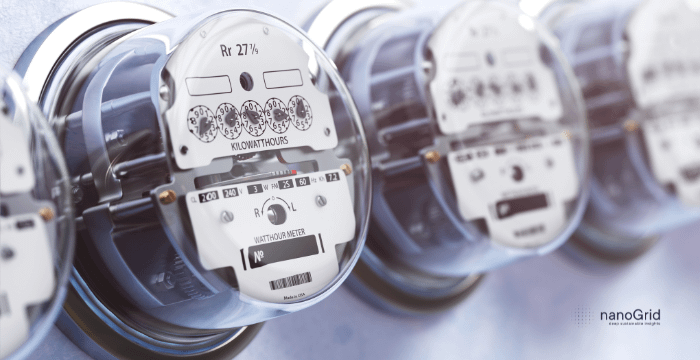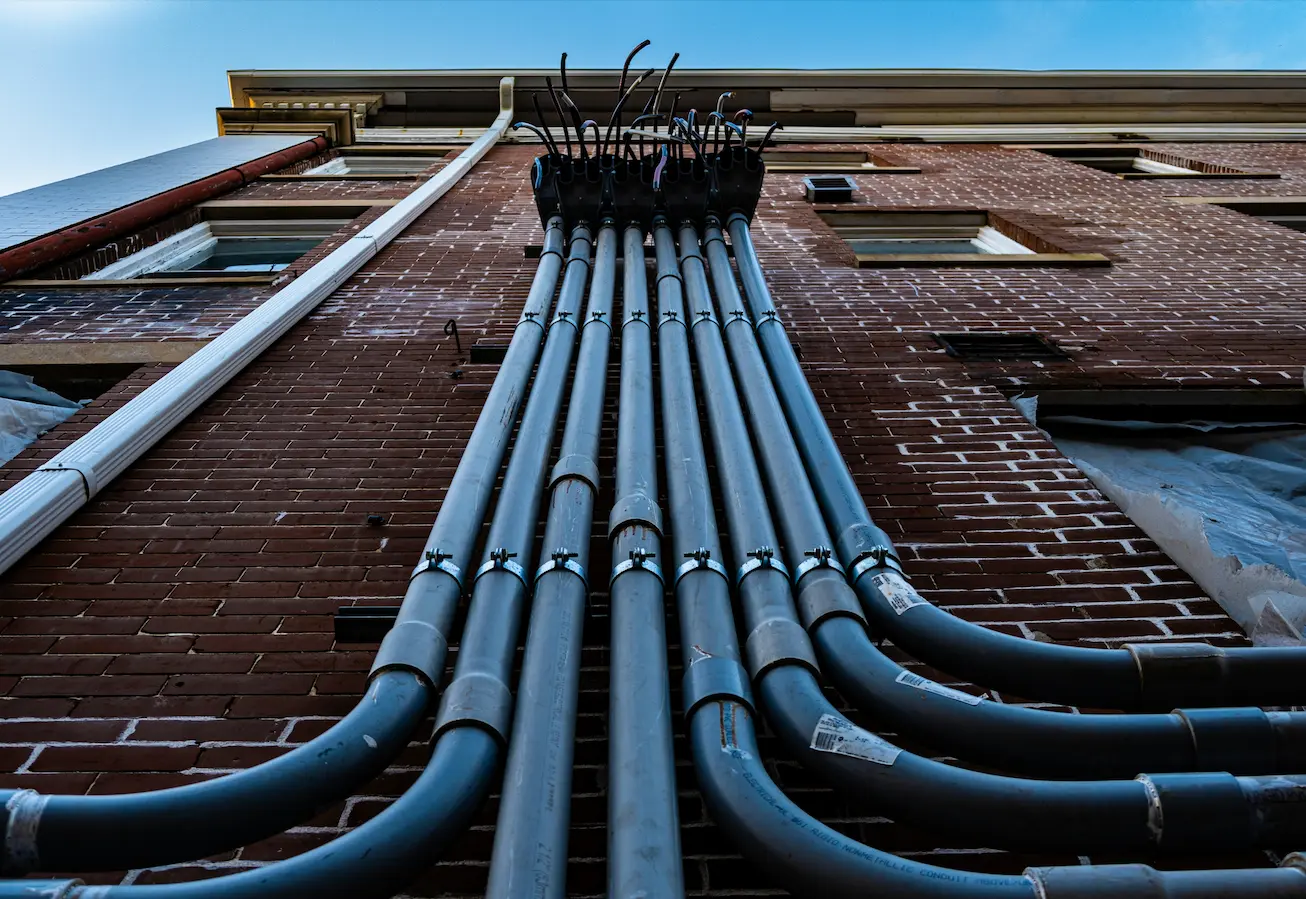Traditional utility meters offer a broad overview of energy and water use but lack the granular data needed for cost-saving decisions. This is where a submeter fills this gap.
In general, a submeter is a secondary utility meter that monitors utilities like electricity, water, and gas. But at a more detailed, granular level than the building’s main meter. Unlike traditional metering, which only shows total usage. Submetering breaks down consumption by tenant, department, equipment, installations or even specific areas.
Let’s break down what a submeter does, how it tracks consumption, and why it matters to both tenants and property owners.
What exactly is a submeter
A submeter is an advanced utility measurement device that works downstream from the main meter to track energy or water usage. While a main meter records total consumption for an entire building. Submeters divide and assign that usage to individual tenants, floors, equipments, or even production lines.
How does a submeter differ from a main meter?
| Main Meter | Submeter | |
|---|---|---|
| Measure | Whole-building utility usage | Usage by tenant, department, equipment, … |
| Billing |
|
Accurate cost allocation per user/tenant |
| Granularity | General consumption data | Detailed, sometimes real-time insights |
| Operational Benefit | Limited visibility into inefficiencies | Help you to identify waste & anomalies immediately |
A main meter is typically owned by the utility provider (or DGO), whereas submeters are installed privately by building owners or facility managers to gain better control over costs.
At nanoGrid, we offer a 360° approach to utility data, from installing hardware on-site to offering a SaaS solution for data consolidation and automated sustainability reporting.
Utility Submetering: what can you track and measure?
Submeters aren’t just for electricity, they can track various utilities to help businesses manage costs, optimize usage, and detect inefficiencies. That’s what we call utility submetering.
Let’s explore some utility submeter solutions, to help you better understand how it works.
1. Electricity Submetering
Electricity submetering monitors power consumption by tenant, department, or equipment, helping to identify energy-heavy machines and peak usage times. It is widely applied in offices, factories, warehouses, and commercial spaces to optimize energy efficiency and cost control.

2. Water submetering
Water submetering tracks consumption per unit, preventing excessive waste and detecting leaks early to save thousands of liters and reduce bills. Ideal for multi-tenant properties, hotels, and industrial sites focused on cutting costs and optimizing operations.
3. Gas submetering
Gas submetering is mostly used in HVAC systems, industrial heating, and gas-powered equipment to optimize consumption and prevent overuse. It helps for examle factories, hospitals, and commercial kitchens cut operational costs while improving efficiency.
4. Thermal & Steam submetering
Submetering tracks high-energy industrial systems like compressed air and steam. It monitors compressed air systems, preventing leaks and inefficiencies, and optimizes steam-based processes, which require extreme heat and are highly energy-intensive. By identifying waste in these expensive energy forms, submetering enhances performance and cuts unnecessary costs.
Submetering drives efficiency and cost savings, but why should businesses and property owners care?
Why should businesses & propery owners care?
For businesses managing multiple locations, facility owners overseeing tenants, or industrial sites optimizing operations. A submeter helps pinpoint inefficiencies, reduce costs, and ensure fair billing.
Without it, companies lack the visibility needed to track individual energy users, leading to waste, disputes over costs, and difficulty meeting sustainability targets.
Who needs a submeter? Key users & their wins
The main winners of installing a submeter are mostly:
- Property Owners & Landlords: Ensure accurate tenant billing, eliminating disputes over “shared” utility costs.
- Businesses & Industrial Sites: Monitor equipment and production line efficiency, reducing energy waste and preventing costly downtime.
- Multi-Tenant Commercial Buildings: Track utility consumption per tenant, encouraging responsible usage and reducing overall expenses.
- Facility & Sustainability Managers: Improve energy efficiency, comply with sustainability regulations, and track Scope 1 & Scope 2 emissions.
Without submetering, businesses lack visibility and depend on estimates. With it, they unlock real-time insights, cost control, and transparency.
Want to learn more? Visit our article about submetering and how it’s linked to CSRD, ESG.
The two main stakeholders: owners vs. occupiers
In our opinion, a submeter profits both property owners and tenants, though their priorities differ.
Owners focus on data, asset value, and operational efficiency, while tenants seek fair billing, efficiency and energy savings.

How property owners use submeter solutions for cost savings & asset value
For property owners, facility managers, and real estate investors, submetering is a powerful tool for financial and operational optimization.
- Reduces overall energy waste: Submetering identifies inefficiencies in lighting, HVAC, and production equipment, preventing excessive costs.
- Optimizes asset performance: By benchmarking energy use across locations or departments, owners can detect underperforming assets and schedule maintenance before failures occur.
- Improves property valuation: Buildings with submetering systems are more attractive to tenants and often qualify for higher BREEAM, CRREM scores, making them more valuable and beloved by investors.
- Ensures accurate cost recovery: Property owners can fairly allocate utility costs to tenants based on actual usage instead of estimations or outdated formulas.
- Prepares buildings for future ESG compliance: As corporate sustainability reporting becomes mandatory, submetering ensures that buildings are equipped with data-driven energy management, and the speicfic amount of costs and usage is exactly clear.
Curious about how submetering connects to ESG and sustainability reporting? Check out our in-depth article for insights.
Example: Multi-Tenant Commercial Buildings
In multi-tenant offices or retail spaces, energy costs are often split equally, regardless of actual usage. This can lead to disputes and uneven costs.
A submeter removes guesswork, ensuring tenants pay only for what they consume, creating a fair and transparent billing system. Property owners recover costs accurately, avoiding financial losses from underbilling or disputes.

How tenant submetering benefits from fair billing and efficiency
For tenants, whether in residential, commercial, or industrial settings, submetering brings control, efficiency and cost savings.
- Fair utility billing: As mentioned before, instead of splitting costs equally, tenants pay only for what they use, preventing overcharges.
- More responsible consumption: With real-time insights into their energy and water usage, tenants adopt energy-efficient behaviors.
- Improves transparency: Tenants can track their consumption patterns, giving them data-backed control over their usage
- Detects unexpected or spikes: If energy usage suddenly increases, tenants can identify the cause and prevent unnecessary charges. Without a submeter these spikes would possibly occur unnoticed.
Example: Industrial plants and processes
In our experience, manufacturing facility with multiple production lines and high-energy processes benefits from a submeter.
Because it tracks energy-intensive equipment like HVAC, compressed air, and steam systems while benchmarking production lines to detect inefficiencies or leaks.
It also helps prevent billing disputes between departments or divisions, ensuring accurate cost allocation.
What are the challenges of implementing a submeter?
While submeters offer huge benefits, businesses must overcome certain challenges before implementation. Understanding these hurdles upfront helps organizations make informed decisions and maximize the return on investment (ROI).
1. Installation costs
In other words, the balancing act between CapEx (capital expenditures) and OpEx (operational expenditures). Businesses must invest in utility infrastructure and technology while managing ongoing operational costs, ensuring their financial strategies align with sustainability goals. Purchasing and installing hardware adds to CapEx, increasing overhead costs.
The costs include hardware expenses for purchasing submeters, sensors, and data loggers, along with installation and labor costs that vary based on property size, wiring, and accessibility.
Additionally, integration with existing systems is crucial to ensure compatibility with current energy management platforms.
2. The tenant dillema
Another challenge issue is lack of tenant or employee engagement. If tenants don’t understand how submetering benefits them, they may resist the change. This is what we call at nanoGrid: the tenant dilemma.
Educating them on its advantages, such as fair billing and cost savings, and providing access to real-time consumption dashboards helps drive acceptance and participation.
3. Regulatory considerations
Submetering regulations can vary by country and industry, making compliance something to definitely keep in mind.
- Submetering regulations vary by location and country, so it’s essential to review local legislation before operating or expanding into new markets.
- Utility Restrictions: Some utility companies impose restrictions on third-party submeters or mandate certified installations to ensure compliance with safety and billing standards, while there are not really consensus in European law and over the rest of the world. We as nanoGrid, follow this topic closely.
- CSRD & ESG compliance: As mentioned a few times before, CSRD and ESG compliance are getting more and more stricter and mandatory. Submetering is often recommended best practice for sustainability reporting.

The Future of the submeter – what’s next?
Submetering is evolving beyond consumption tracking. With IoT and AI advancements, it is becoming smarter, more automated, and essential for sustainability efforts.
IoT-enabled submeters provide real-time utility tracking across multiple locations by pushing data to the cloud, ensuring precise and reliable insights for optimization. AI-driven analytics detect anomalies such as energy spikes or equipment inefficiencies, allowing businesses to make proactive adjustments, reduce waste, cut costs, and enhance efficiency
Governments and regulators are moving toward mandatory energy tracking, making a submeter the next logical step. While not yet required in all industries, early adopters gain a competitive edge by staying ahead of regulations and efficiency.
Conclusion: a submeter isn’t just an ordinary meter, more a competitive advantage
Still wondering what is a submeter and why it matters?
The answer is simple: it’s the key to cost control, energy efficiency, and sustainability compliance.
Without a submeter, businesses operate in the dark, facing waste, billing disputes, and missed savings opportunities.
By providing granular insights, a submeter helps property owners allocate costs fairly, facility managers eliminate inefficiencies, and businesses stay ahead of sustainability regulations. And with IoT-driven advancements, it’s no longer just about tracking, it’s about optimizing and future-proofing operations.
The real question isn’t if you need a submeter, it’s how much are you losing without one?
nanoGrid gives you the total view and data – Real-time utility monitoring, anytime, anywhere
At nanoGrid, we specialize in real-time submetering, providing businesses with full visibility into their energy consumption through the most accurate and reliable utility data.
Our technology tracks electricity, gas, water, and gasoil by the minute, securely storing data in the cloud and displaying real-time insights through the nanoGrid app, where users can analyze trends, compare locations, and export reports.
With intelligent alerts that detect anomalies, companies can prevent waste, lower costs, and optimize efficiency, making data-driven decisions that support both financial performance and sustainability goals.
Interested how we cover almost 100% of your utility data? Contact us and we’ll be in touch right away.



